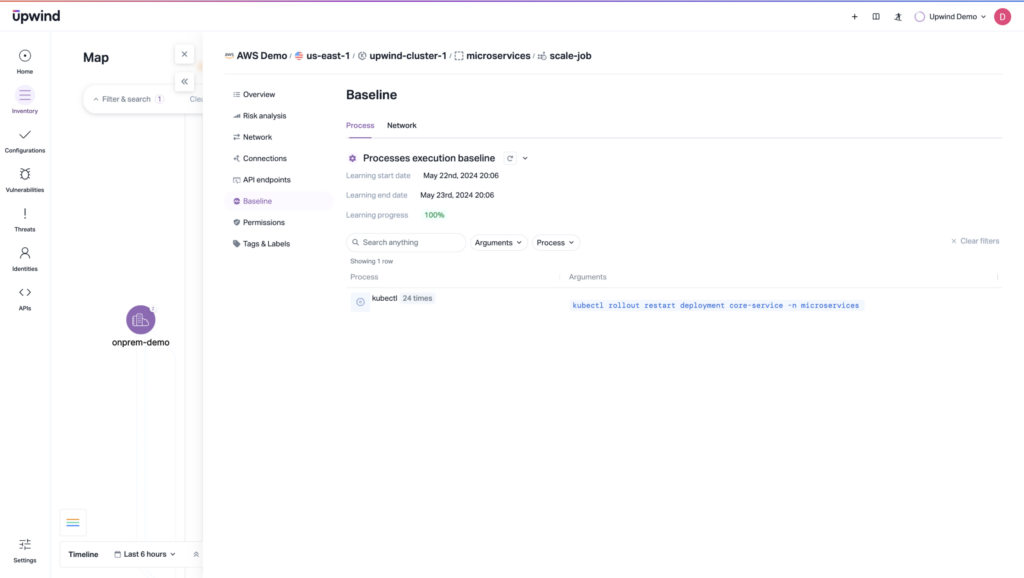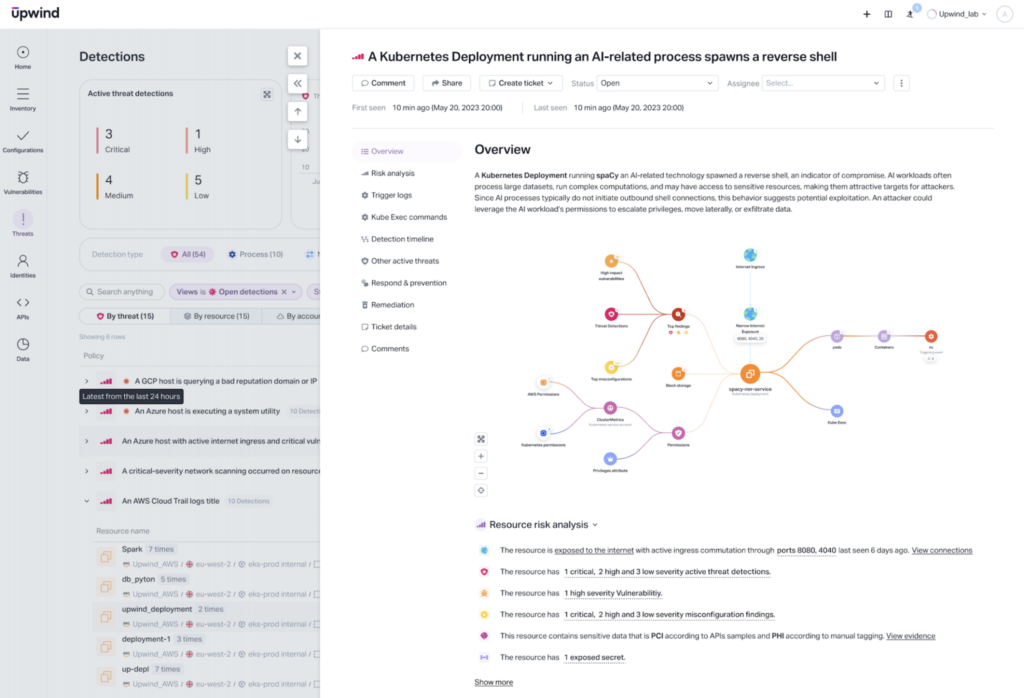
The rise of artificial intelligence (AI and its rapid adoption across the enterprise landscape have brought about both unprecedented opportunities and profound challenges, particularly in the realm of data security. On one hand, AI-driven solutions powered by large language models (LLMs) are unlocking new levels of automation, enhancing how organizations approach cybersecurity. But as AI adoption grows, so does the volume of data being processed; this makes modern, data-intensive infrastructures increasingly attractive to threat actors.
We’ve talked about dark AI, AI threat detection, and adversarial AI. But what about the data? This article explores the core principles of AI data security, highlighting key components and best practices for protecting AI workloads across the enterprise.
First Things First: AI Data Security Fundamentals
AI data security includes the methods used to protect sensitive data that AI systems use, generate, and store. It includes training data, but also models themselves, along with prompts and outputs, AI data security:
- Protects training, fine-tuning, and runtime data from breaches
- Secures model inputs and outputs against data leakage
- Guards against adversarial attacks to corrupt model behavior
- Makes sure models are compliant with privacy laws like GDPR and HIPAA
- Mitigates risk across the AI lifecycle
From training data to real-time user inputs, AI systems interact with sensitive information at every stage of the machine learning (ML) pipeline. This growing complexity in enterprise cybersecurity has made the data powering AI-driven security systems a target.
A Netacea survey revealed that 93% of businesses expect daily attacks on AI systems.
AI relies on vast amounts of information to function, learn, and continuously improve its predictions over time. But at the heart of these processes are the ML models that enable systems to learn from data without being explicitly programmed — the more diverse and high-quality the data, the more effective and accurate AI systems become. AI data security is focused on protecting these data workloads, even as the data powering them gets exponentially larger all the time.
The Dual Role of AI in Modern Security
AI introduces new security risks — but it also strengthens an organization’s security posture. Of course, the data fueling AI models isn’t just an input; it’s an extension of the organization’s attack surface. If compromised, training data and fine-tuning datasets, or even runtime inputs, stand to corrupt model integrity, leak sensitive information, or expose vulnerabilities at scale.
But data plays a dual role. It also enables more accurate threat detection and response. That allows organizations to pick up AI tools to protect the confidentiality, integrity, and availability of their data across its lifecycle, even as they struggle to protect their own AI resources.

Runtime and Container Scanning with Upwind
By continuously monitoring the runtime environment, including the containers, libraries, processes, and data flows that support AI models, runtime security helps security teams detect vulnerabilities, misconfigurations, and malicious activity targeting of AI workloads during execution up to 10X faster than traditional scanning.
Why AI Data Security Matters in a Cloud-Native World
In cloud-native environments, data isn’t confined to a centralized system. Instead, it flows constantly across containers, microservices, serverless functions, and third-party APIs. AI models operating in these architectures must ingest, process, and adapt to a steady stream of dynamic, distributed data.
What does it matter? First, the data used to train and operate models can reside in multiple locations, each with its own exposure and control challenges. Second, any compromise of that data can undermine the model, regardless of whether it was breached during storage, transit, or real-time inference.
According to a 2023 IBM survey, 82% of data breaches involve cloud storage. And those breaches are getting more serious, with costs up 15% year over year.
The cloud can be an irresistible target for cybercriminals: attackers tampering with AI data can introduce bias into defenses or open new avenues for lateral movement.

Key Risks in AI Data Security
Securing AI systems goes beyond protecting static databases to looking at how data moves, evolves, and is exploited across the full AI lifecycle. The following risks highlight some key failure points where compromised data can undermine model integrity, leak sensitive information, and open up other areas of the cloud environment to attack.
Data Poisoning, Model Inversion, and Other Emerging Security Threats
AI models are only as trustworthy as the data they were trained on. In data poisoning attacks, malicious actors inject misleading data into the training process, compromising the model’s accuracy and reliability, while model inversion attacks can reverse-engineer AI models to expose confidential data used in their training, threatening both security and privacy.
Both highlight that attackers don’t need model source code, but that they can target upstream data sources, APIs, or user input data directly to compromise model behavior at runtime.
Security Blind Spots in ML Pipelines
ML pipelines often harbor security blind spots that can leave them vulnerable to attacks, particularly in areas like data collection, preprocessing, and model deployment. These gaps allow adversaries to manipulate or corrupt training data, exploit weaknesses in model validation, or introduce biases, ultimately undermining the system’s integrity and efficacy.
Data Privacy Vulnerabilities in AI Systems
Machine learning pipelines are dynamic, spanning multiple cloud services, third-party tools, and automated stages, so each introduces its own security gaps. Data ingestion points can allow poisoned inputs, preprocessing scripts can inadvertently leak features or labels, model validation processes can fail to detect adversarial drift, and deployment environments can expose models to extraction.
Blind spots emerge because traditional DevSecOps approaches aren’t equipped to monitor or validate the non-code artifacts in ML pipelines, like datasets, model weights, and feature transformations. They need real-time observability instead.
Real-World AI Security Incidents
Recent real-world AI security incidents illustrate the growing risks posed by AI systems _ and how blind spots in data security can lead directly to breaches and exploitation. Here are a few key examples where weaknesses in data handling, model governance, and pipeline security were specifically targeted.
| Date | Event | Organization | Data Exposed | Impact |
| 2/2025 | DarkMind Release | Saint Louis University | N/A | Security researchers developed a novel backdoor attack capable of subtly manipulating the text generation of large language models (LLMs), all while remaining highly difficult to detect. |
| 1/2025 | DeepSeek Data Breach | DeepSeek | 1M+ records | Chinese AI analytics firm DeepSeek suffered a major data breach that exposed over one million sensitive records, including chat logs, API keys, and internal data. |
| 2/2024 | BEAST Release | University of Maryland | N/A | Security researchers devised an efficient method for crafting prompts that can trigger harmful responses from LLMs, highlighting vulnerabilities in their response safeguards. |
| 3/2023 | OpenAI Data Breach | OpenAI | 1.2% of ChatGPT Plus users’ data | A data breach resulted in the exposure of approximately 1.2% of ChatGPT Plus users’ data, including names, chat histories, email addresses, and payment information. |
Though they reflect different failure points, from poisoned training data to unsecured runtime environments, together they highlight that securing AI systems is not about static data and strong perimeters; it requires continuous visibility, validation, and defense across the entire AI data lifecycle.
Best Practices for Securing AI-Powered Environments
Securing AI environments doesn’t mean bolting traditional security controls onto new systems. It needs a lifecycle approach with continuous monitoring that addresses the unique ways data, models, and the cloud environment interact. Here are the principles that help ensure both the integrity of models and the protection of the data they rely on.
Protect Training Data and Model Integrity at Every Stage
Track the provenance of every dataset feeding models, enforce cryptographic validation where possible, and monitor for anomalies during data ingestion. Build auditability into pipelines, using clear records of training data sources, transformations, and model versions so teams can spot drift, poisoning attempts, or adversarial influence faster.
Apply Identity, Access, and Behavior Controls Across Models, API, and Data
Extend zero trust architecture to the AI stack along with users and endpoints. Define strict role-based access controls (RBAC) for datasets, model artifacts, and inference APIs. Continuously monitor behavioral baselines for users and systems interacting with AI resources, flagging anomalies like prompt injection attempts or excessive API calls.
Continuously Monitor Workload Risk and Runtime Behavior
Deploy runtime protection to actively monitor AI workloads in production so teams see drift, adversarial inputs, and extraction attempts. Treat risk scoring as a live process and be ready to update threat models as new data sources, APIs, or fine-tuned models are introduced.
Secure the AI Lifecycle from Data Collection to Deployment
Implement security controls to protect data across phases:
- Collect data securely by validating sources, encrypting data in transit and at rest, and verifying integrity before ingestion.
- Harden training environments with adversarial testing, least-privilege access to infrastructure, and strict versioning.
- Strengthen model validation by testing for leakage risks, inversion vulnerabilities, and susceptibility to bias.
- Protect deployed models and inference APIs with rate limiting, output sanitation, authentication, and anomaly monitoring.
Implementing AI Data Security Across the Enterprise
Beyond tech controls, organizations need to design security practices that account for how AI data, models, and pipelines exist in cloud-native architectures (and hybrid environments, too). Effective AI data security will require continuous validation, architectural guardrails, and adaptive governance.
Architect AI Data Security as a Continuous System, Not a Point Solution
Shift from audits to persistent observability of AI assets and their data throughout the AI lifecycle. Implement systems that continuously track the security posture of AI data sources, training datasets, models, APIs, and outputs in production.
Design telemetry flows and asset inventories that capture how models and datasets evolve.
Treat Model Supply Chains Like Critical Infrastructure
Map the supply chain for every AI asset: datasets, foundation models, fine-tuning scripts, pipelines, APIs, and external service dependencies. Apply the same discipline to AI assets as teams apply to critical software supply chains, with trust verification, version control, dependency scanning, and risk scoring. Then, integrate threat modeling for AI-specific supply chain risks, like adversarial dataset pollution.
Establish Ownership and Accountability for AI Assets
Assign explicit ownership for every model, dataset, and training pipeline, including security accountability. Define who is responsible for model security controls, retraining hygiene, output monitoring, and compliance validation. Avoid shadow AI proliferation by requiring formal documentation and security validation for any model introduced into enterprise workflows.
Integrate Security into AI Decision Workflows
Move beyond ad hoc compliance checks and automate real-time validation of data sourcing, privacy labeling, and data minimization in AI pipelines.
Be sure to carefully analyze and review local and regional data security and privacy laws like the EU’s General Data Protection Regulation (GDPR) and the California Consumer Privacy Act (CCPA), then implement active controls across training and inference stages, with automated and active controls. Use machine-readable compliance tagging where possible to maintain traceability for sensitive data usage in the cloud.
Upwind Secures Workloads in Real Time
When you’re running AI models in containers in the cloud, runtime monitoring with machine learning-backed anomaly detection gives you the power to:
- See vulnerabilities in containers and libraries
- Find misconfigurations that threaten your AI workloads
- Spot process anomalies inside the model-serving app
- Flag unexpected file system activity, like model artifact tampering
- Identify data flows, including large data exfiltration attempts
Want to see how you can protect the infrastructure underpinning your models? Schedule a demo.
FAQs
How does AI data security differ from traditional data security approaches?
Though it’s the outsized datasets that first piqued security interest in AI models, it’s the dynamic data flows, model behavior, and adaptation in real time that are key challenges in securing AI models. Here are the differences to pay attention to:
- Training data is a permanent attack surface: Models can memorize, leak, and be manipulated.
- Inference adds live exposure points: Every prompt or API connection is a risk vector for data leakage or exploitation.
- Supply chains are tough to track: Models can be built on layered, third-party datasets with pretrained components.
- Behavioral risks remain post-deployment: Models can drift or behave in unexpected ways. Security can degrade.
- Traditional controls miss dynamic artifacts: Pipelines, feature transformations, and new versions all create new blind spots.
- Privacy challenges are bigger: AI can accidentally produce sensitive information from anonymized training data.
Ultimately, traditional data security protects the data that organizations store. But AI data security needs to protect how systems learn and react.
What compliance frameworks apply specifically to AI data security?
Several compliance frameworks have emerged in recent years to address AI data security:
- NIST’s AI Risk Management Framework: A voluntary best practices standard for securing and validating AI models and data pipelines.
- ISO/IEC 42001: A standard strictly for AI management, with lifecycle governance.
- EU AI Act (EU): Introduces risk tiers for AI systems and requirements for high-risk models, including for data governance.
- GDPR (EU): Applies to AI systems processing personal data and covers consent, explainability, and erasure.
- CCPA (California): Requires transparency around data use and enforces opt-outs.
- HIPAA: Healthcare-specific data regulations around personal data.
How can organizations secure AI data across hybrid and multi-cloud environments?
Securing AI data across hybrid and multi-cloud environments requires implementing a unified security strategy that includes end-to-end encryption, secure data access controls to prevent unauthorized access, and consistent monitoring across all platforms. Organizations should:
- Encrypt data end-to-end
- Implement unified identity and access management (IAM)
- Segment and tag AI data
- Monitor runtime behavior continuously
- Secure model-serving infrastructure
- Audit multi-cloud configurations for AI exposure risks like open storage buckets and API gateways
What role does runtime security play in protecting AI systems?
Runtime security protects AI systems while they’re live, but it’s not about protecting models. Instead, runtime security protects the infrastructure around AI models, including:
- Monitoring for vulnerabilities, misconfigurations, and suspicious activity in containers, APIs, and the runtime environment
- Flagging anomalous behavior, like unexpected data flows
- Protecting data in motion
- Detecting inference-time risks like prompt injection attempts
- Triggering automated response actions, from revoking API access to isolating containers
Runtime security doesn’t govern model logic. Instead, it secures the dynamic environment that AI systems depend on to operate safely.
How can teams measure AI data security success?
Measuring AI data security success means tracking the resilience of AI systems, pipelines, and data flows. Here are some key metrics to get on the radar:
- Mean Time to Detect (MTTD) and Mean Time to Respond (MTTR): Specifically for AI-related incidents like inference abuse, data leakage, or drift.
- Volume and severity of AI-specific security incidents: Tracking model exposures, adversarial attacks, and data breaches tied to AI pipelines.
- Coverage of AI assets under runtime monitoring: Percentage of models, datasets, APIs, and containerized workloads that are actively observed.
- Compliance audit success: Percentage of models and datasets that meet privacy and regulatory requirements.
- Reduction in untracked or shadow AI: Fewer unmanaged models and datasets operating outside governance.
Measuring success is about proving the team is making advancements that help their systems adapt faster than attack tactics.






